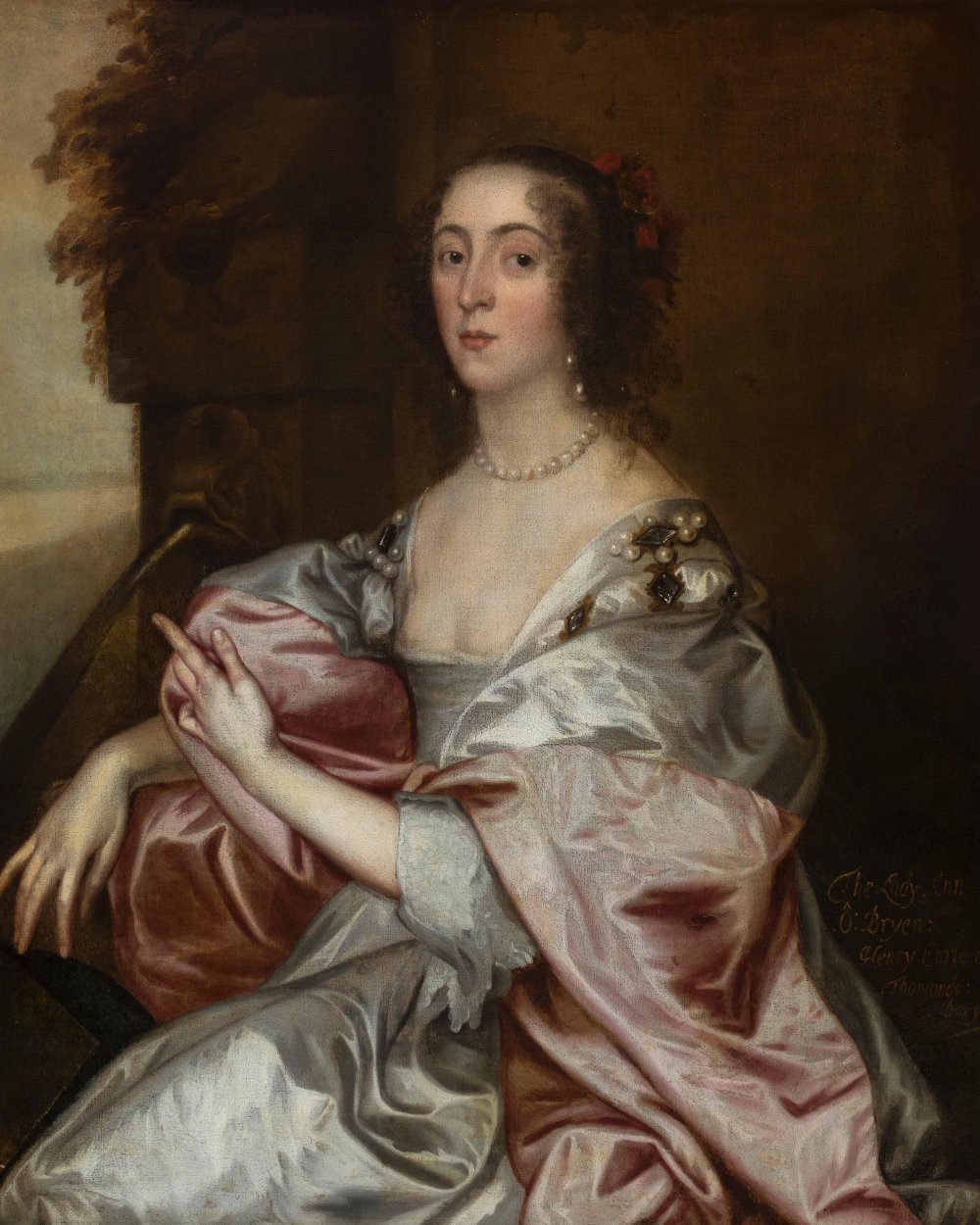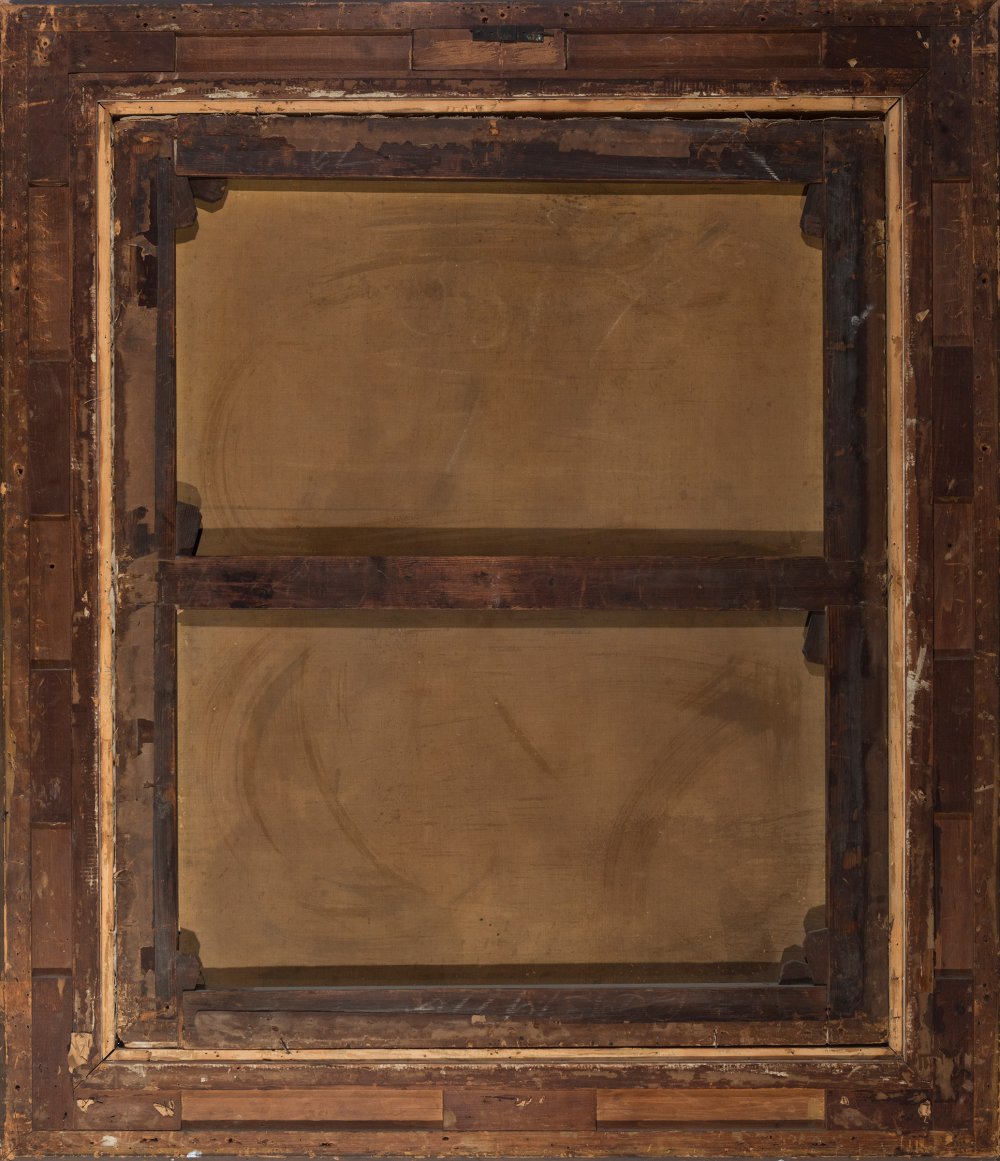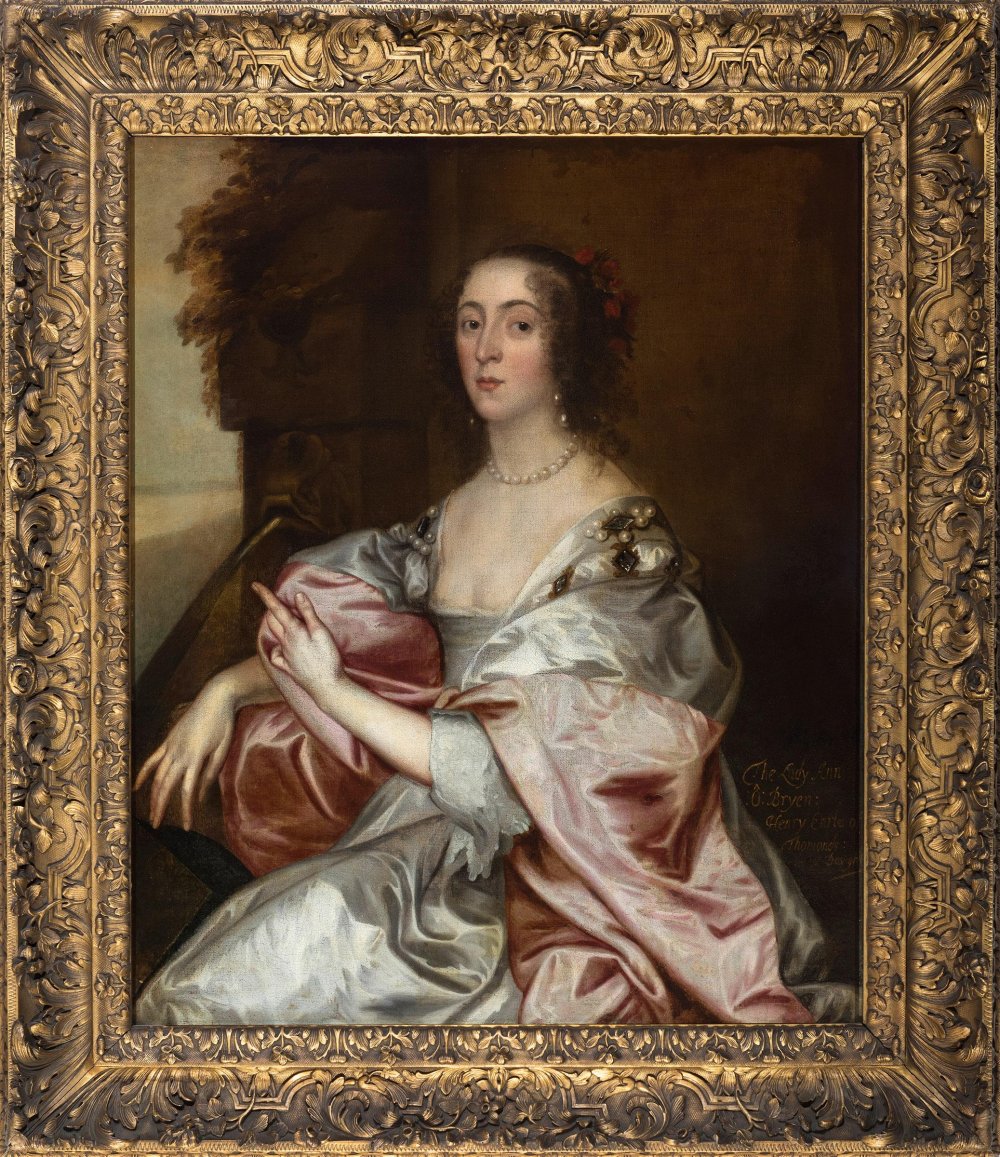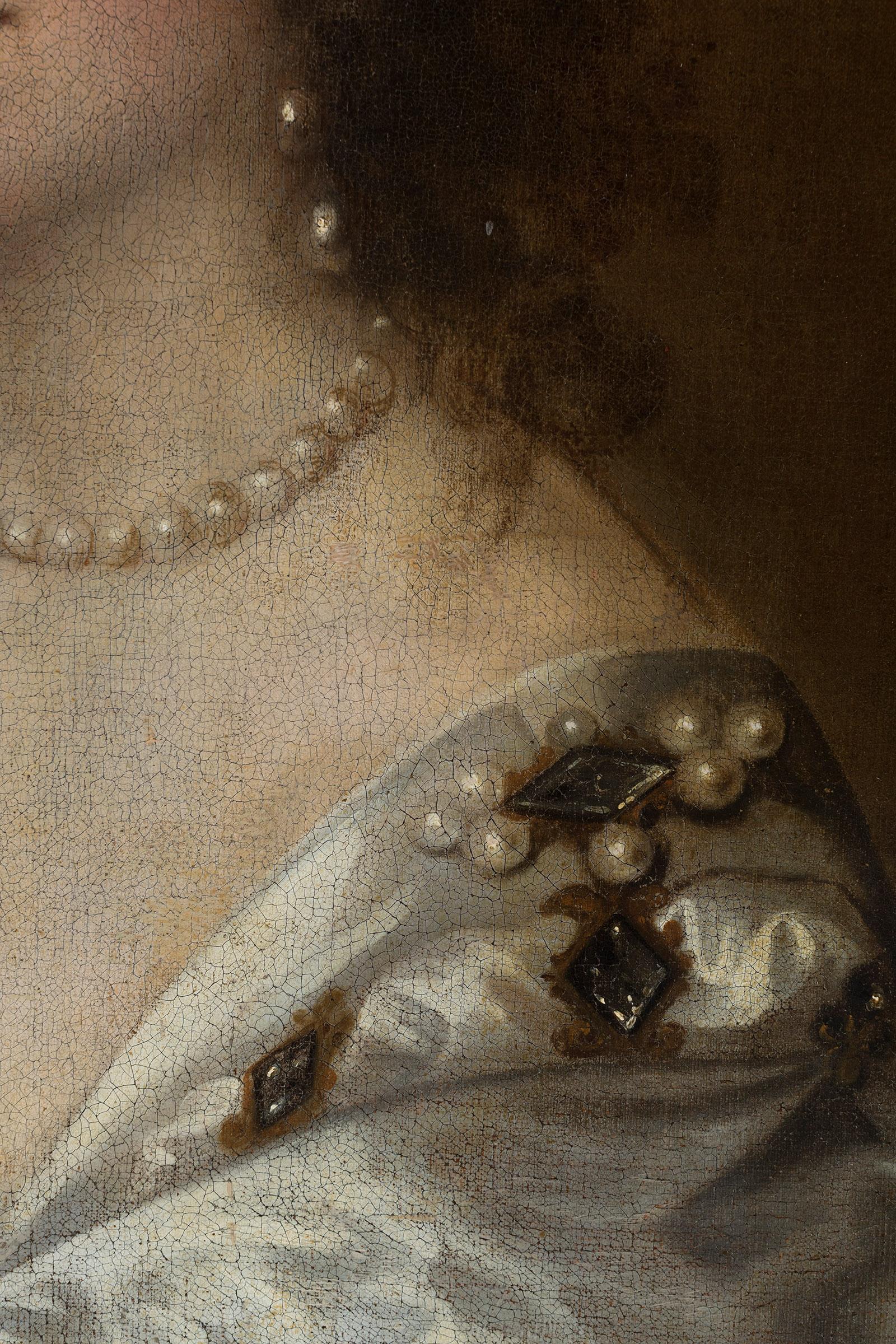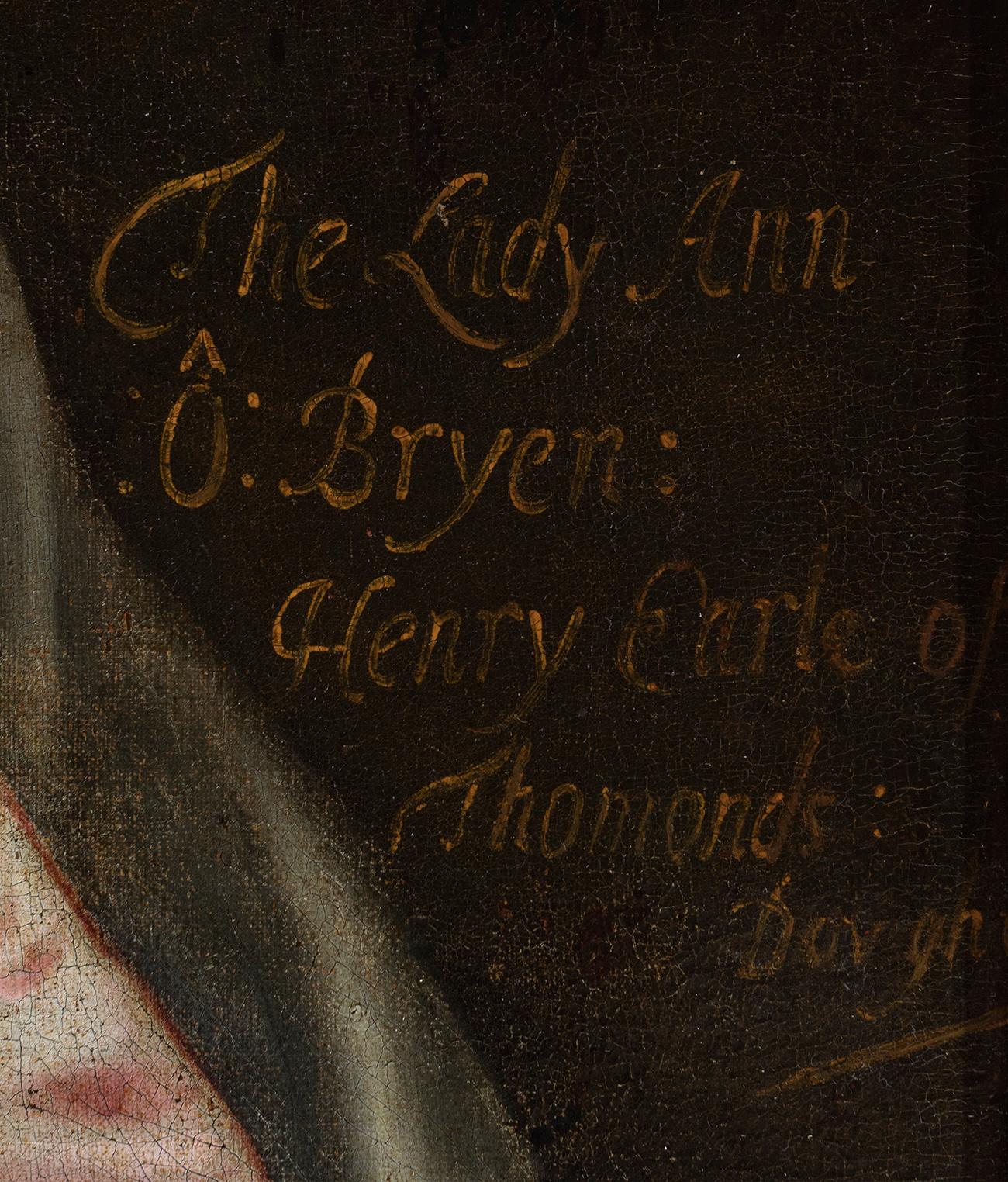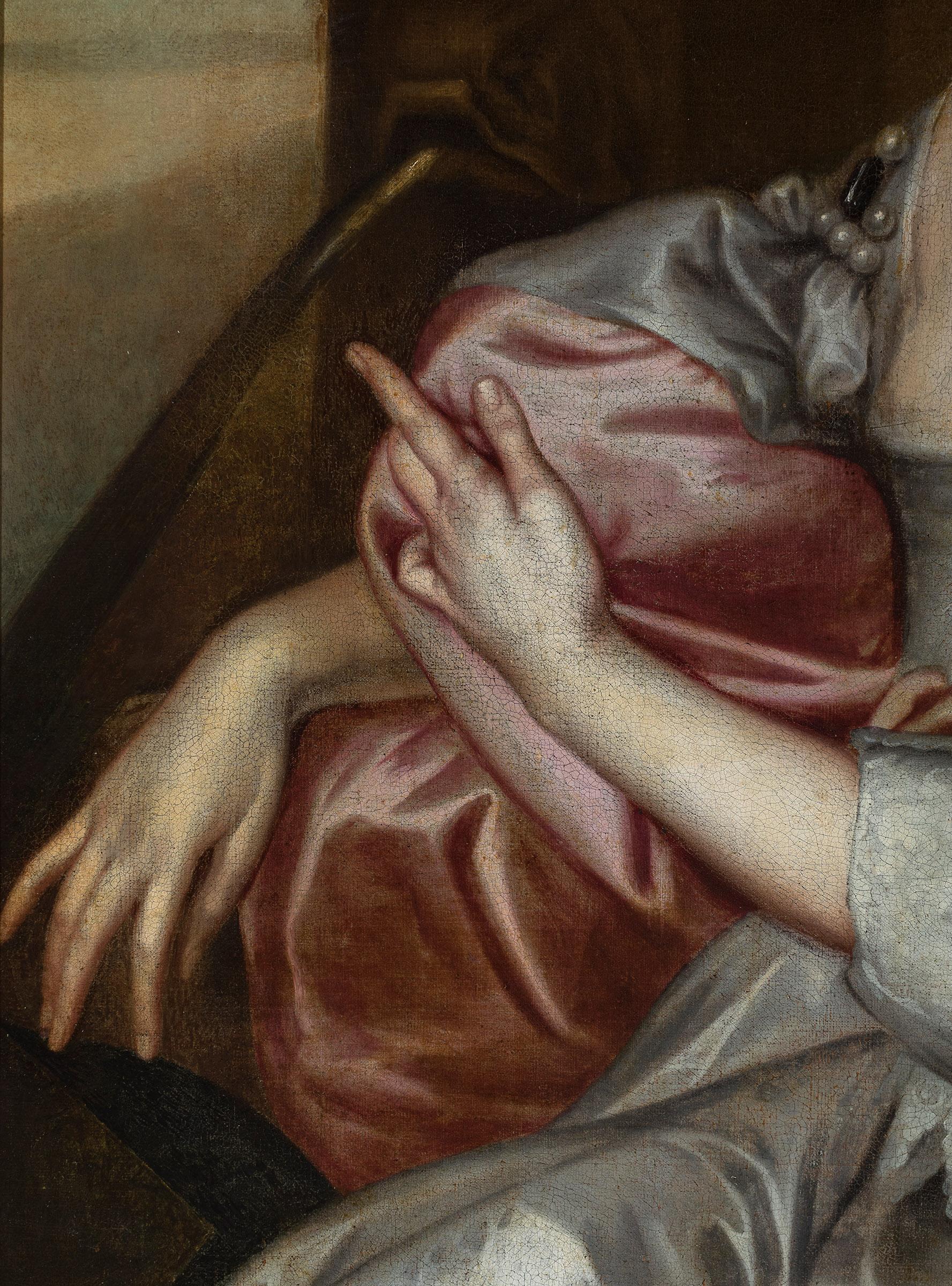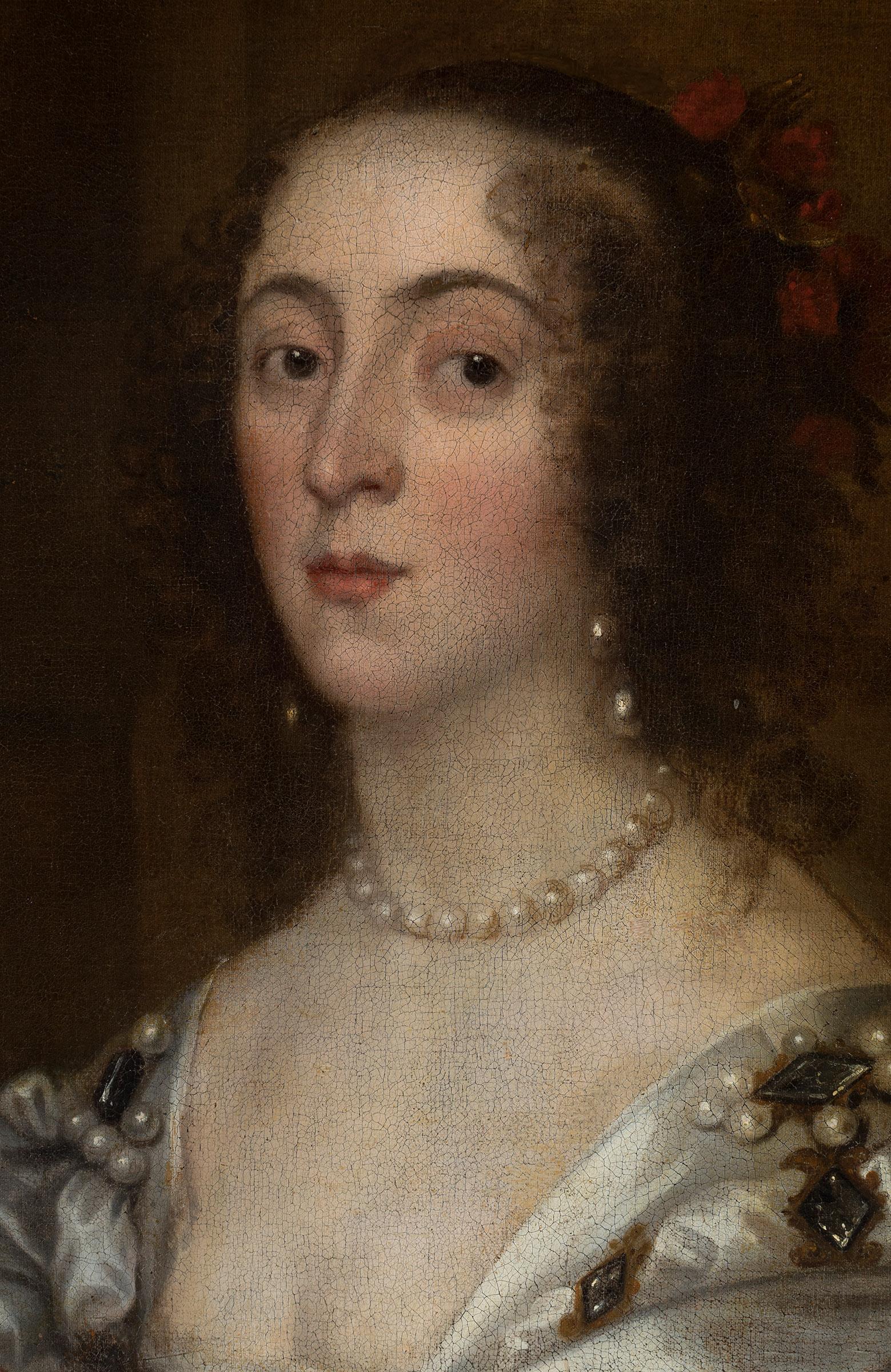40
17th century English school."Portrait of Lady Anne O'Brien".Oil on canvas. Re-coloured.With
"Portrait of Lady Anne O'Brien".
Oil on canvas. Re-coloured.
With inscription in the lower right corner.
Frame with slight faults.
Size: 105 x 85 cm; 138 x 118 cm (frame).
In this canvas the painter offers us the portrait of a young lady of beautiful features and elegant position, dressed in the English fashion of the 17th century. The inscription in the lower right-hand corner indicates that she is Lady Anne O'Brien, the fourth daughter of Henry O'Brien, the fifth Earl Thomond, a descendant of an important Irish Gaelic dynasty, who in turn descended from Brian Boru (an important medieval king of Ireland). Anne, the protagonist of our play, married the seventh Earl of Thomond, also known as Sir Henry O'Brien, and died in 1645. She wears a voluptuous dress decorated with puffed sleeves and a straight, period neckline. Around her delicate neck she wears a pearl necklace to match her earrings. With her left hand she makes a peculiar gesture, with her index finger and thumb stretched out, pointing to something that could be outside the room in which she is depicted, far from the viewer's sight. This gesture can also be related to the figure of her husband, as it could point to the portrait of Sir Henry O'Brien, which may have been painted to form a pair with the present one. On a formal level, it is worth mentioning how the figure is strongly illuminated, standing out against a neutral background that suggests the walls of a fortification and allows us to glimpse a landscape, something very much in keeping with the English fashion of the time. The brushstroke used by the artist changes, being much more precise, practically invisible, on the woman's face, hair and bust, but looser on the dress and background. Due to the technical and formal characteristics mentioned above, this is a work close to the circle of Pieter Van del Faes Lely (1618-1680), an English portraitist clearly influenced by Anton Van Dyck. The son of a Dutch father, Lely studied in Haarlem. In 1641 he decided to move to London, where he imbibed English taste. He specialised in portraiture and was appointed painter to the court of Charles I. Museums such as those in London and Dublin, and collectors at Hampton Court and Windsor own works by this well-known artist.
In the 18th century the European portrait scene was varied and wide-ranging, with numerous influences and largely determined by the tastes of both the clientele and the painter himself. However, this century saw the birth of a new concept of portraiture that would evolve throughout the century and unify all the national schools: the desire to capture the personality and character of the human being, beyond his external reality and social rank, in effigy. During the previous century, portraiture had become established among the upper classes and was no longer reserved solely for the court. For this reason, as the 17th and even more so in the 18th century, the formulas of the genre became more relaxed and moved away from the ostentatious and symbolic official representations typical of the Baroque apparatus. On the other hand, the 18th century reacted against the rigid etiquette of the previous century with a more human and individual conception of life, and this was reflected in all areas, from furniture, which became smaller and more comfortable, replacing the large gilded and carved pieces of furniture, to the portrait itself, which came to dispense with all scenographic elements in order to depict the individual rather than the personage.
"Portrait of Lady Anne O'Brien".
Oil on canvas. Re-coloured.
With inscription in the lower right corner.
Frame with slight faults.
Size: 105 x 85 cm; 138 x 118 cm (frame).
In this canvas the painter offers us the portrait of a young lady of beautiful features and elegant position, dressed in the English fashion of the 17th century. The inscription in the lower right-hand corner indicates that she is Lady Anne O'Brien, the fourth daughter of Henry O'Brien, the fifth Earl Thomond, a descendant of an important Irish Gaelic dynasty, who in turn descended from Brian Boru (an important medieval king of Ireland). Anne, the protagonist of our play, married the seventh Earl of Thomond, also known as Sir Henry O'Brien, and died in 1645. She wears a voluptuous dress decorated with puffed sleeves and a straight, period neckline. Around her delicate neck she wears a pearl necklace to match her earrings. With her left hand she makes a peculiar gesture, with her index finger and thumb stretched out, pointing to something that could be outside the room in which she is depicted, far from the viewer's sight. This gesture can also be related to the figure of her husband, as it could point to the portrait of Sir Henry O'Brien, which may have been painted to form a pair with the present one. On a formal level, it is worth mentioning how the figure is strongly illuminated, standing out against a neutral background that suggests the walls of a fortification and allows us to glimpse a landscape, something very much in keeping with the English fashion of the time. The brushstroke used by the artist changes, being much more precise, practically invisible, on the woman's face, hair and bust, but looser on the dress and background. Due to the technical and formal characteristics mentioned above, this is a work close to the circle of Pieter Van del Faes Lely (1618-1680), an English portraitist clearly influenced by Anton Van Dyck. The son of a Dutch father, Lely studied in Haarlem. In 1641 he decided to move to London, where he imbibed English taste. He specialised in portraiture and was appointed painter to the court of Charles I. Museums such as those in London and Dublin, and collectors at Hampton Court and Windsor own works by this well-known artist.
In the 18th century the European portrait scene was varied and wide-ranging, with numerous influences and largely determined by the tastes of both the clientele and the painter himself. However, this century saw the birth of a new concept of portraiture that would evolve throughout the century and unify all the national schools: the desire to capture the personality and character of the human being, beyond his external reality and social rank, in effigy. During the previous century, portraiture had become established among the upper classes and was no longer reserved solely for the court. For this reason, as the 17th and even more so in the 18th century, the formulas of the genre became more relaxed and moved away from the ostentatious and symbolic official representations typical of the Baroque apparatus. On the other hand, the 18th century reacted against the rigid etiquette of the previous century with a more human and individual conception of life, and this was reflected in all areas, from furniture, which became smaller and more comfortable, replacing the large gilded and carved pieces of furniture, to the portrait itself, which came to dispense with all scenographic elements in order to depict the individual rather than the personage.
9th November - Old Masters
Sale Date(s)
Venue Address
General delivery information available from the auctioneer
Setdart offers Worldwide shipping
PICK UP IN ROOM: You can come and pick up your lots in our offices (Barcelona, Madrid or Valencia). At the moment of the withdrawal, you will be able to accept the current conditions of the lot by means of a document that you will sign.
YOU CAN SEND ANOTHER PERSON TO PICK UP: This person must present a signed authorization that you can find in our web page by accessing from BUY AT SETDART- LOGISTICS-DOWNLOAD AUTHORIZATION DOCUMENT. You can also send an e-mail with the requested data in AUTHORIZATION DOCUMENT to admin@setdart.com
Important Information
25% buyer´s premium
OR
21% buyer´s premium at www.setdart.com
Terms & Conditions
The maximum period to pay the lots is 7 working days. You can pay either via bank transfer or with credit card through our platform www.setdart.com (we only accept VISA or Mastercard).
BUYER´S PREMIUM: 22% Hammer price + 21% VAT from the buyer´s premium
If your piece has more than 100 years, our Ministry of Culture requires an export certificate in order for the piece to leave the country. Note that if the piece goes inside the EU, there is no cost for the export certificate. If the piece goes outside the EU, there is a cost for the export certificate. You can find more information in our Ministry of Culture website: https://www.culturaydeporte.gob.es/en/cultura/patrimonio/exportacionimportacion/exportacion/tasas.html
INQUIRIES: admin@setdart.com
Setdart guides you through the entire process, from the time of award to the day you receive your lot. Our logistics team will be happy to manage your transport, and will advise you on the best shipping method with professionals from the sector used to handling works of art and jewelry.
WE OFFER WORLDWIDE DOOR TO DOOR SHIPPING
PICK UP IN ROOM: You can come and pick up your lots in our offices. At the moment of the withdrawal, you will be able to accept the current conditions of the lot by means of a document that you will sign.
YOU CAN SEND ANOTHER PERSON TO PICK UP: This person must present a signed authorization that you can find in our web page by accessing from BUY AT SETDART-LOGISTICS-DOWNLOAD AUTHORIZATION DOCUMENT. You can also send an e-mail with the requested data in AUTHORIZATION DOCUMENT to admin@setdart.com
SETDART IS NOT RESPONSIBLE FOR THE STATE OF THE PARTS ONCE THEY LEAVE OUR FACILITIES. MRW SHIPMENTS: Once the payment is made, your lot will be packed for shipment, the logistics department will send you an e-mail notifying you of the day it leaves our warehouse, changes of address cannot be made after receiving this e-mail.
INSURANCE INCIDENTS: Coverage for the value of the auction up to 3000 ? per shipment, if the value of the auction is higher, Setdart will send you a quote including the additional insurance. The insurance company WILL NOT BE RESPONSIBLE FOR THE SHIPMENT THAT EXCEEDS THAT AMOUNT AND IS NOT FULLY INSURED. MRW INCIDENTS: Maximum notification 48 hours after receipt, after which the insurance company WILL NOT BE RESPONSIBLE AND NO CLAIMS WILL BE ACCEPTED.
E-MAIL LOGISTICS: logistica@setdart.com
PICK UP YOUR MESSAGES: You can send your own messaging, prior notice via e-mail that your shipment is ready, please note 3 or 4 days in advance. This type of shipment is packaged so Setdart will provide you with a quote.
EXPENSES FOR STORAGE: We inform you that if the purchased lot is not picked up within a month, you will be charged 30€ per week per lot. Setdart Online S.L., owner of the web site "setdart.com", "setdart.net" and "setdart.org", acts as a company of Spanish nationality inscribed in the Volume 36955, sheet 182, page B-293056 of the Mercantile Registry, with registered office at Calle Aragó















